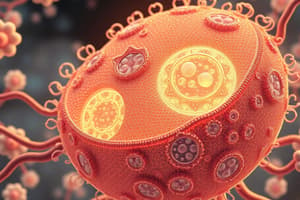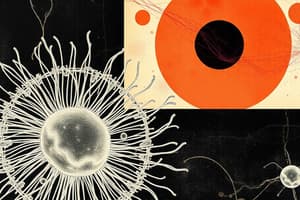Podcast
Questions and Answers
What is the primary function of the cell membrane?
What is the primary function of the cell membrane?
- Providing structural support to the cell
- Generating energy for the cell
- Regulating entrance and exit of substances into the cell (correct)
- Synthesizing carbohydrates
Which model describes the structure of the cell membrane as a 'fluid mosaic'?
Which model describes the structure of the cell membrane as a 'fluid mosaic'?
- Gorter and Grendel Model
- Singer Nicolson Model (correct)
- Davson Danielli Model
- Phospholipid Bilayer Model
Which component is described as the 'main fabric' of the cell membrane?
Which component is described as the 'main fabric' of the cell membrane?
- Phospholipid (correct)
- Integral proteins
- Carbohydrates
- Cholesterol
What did Evert Gorter and Francois Grendel discover about the cell membrane in 1925?
What did Evert Gorter and Francois Grendel discover about the cell membrane in 1925?
What is the meaning of 'homeostasis'?
What is the meaning of 'homeostasis'?
What do integral proteins do in the cell membrane?
What do integral proteins do in the cell membrane?
What is the function of peripheral proteins in the cell membrane?
What is the function of peripheral proteins in the cell membrane?
How does cholesterol maintain the integrity and fluidity of the cell membrane?
How does cholesterol maintain the integrity and fluidity of the cell membrane?
What is the function of carbohydrates in the cell membrane?
What is the function of carbohydrates in the cell membrane?
Which of the following best describes passive transport across cell membranes?
Which of the following best describes passive transport across cell membranes?
What is the process of osmosis?
What is the process of osmosis?
How does facilitated diffusion occur?
How does facilitated diffusion occur?
Flashcards are hidden until you start studying
Study Notes
Cell Membrane Structure and Function
- The primary function of the cell membrane is to regulate what enters and leaves the cell.
Fluid Mosaic Model
- The fluid mosaic model describes the structure of the cell membrane, proposing that it is a dynamic and flexible structure composed of a phospholipid bilayer embedded with proteins.
Phospholipid Bilayer
- The phospholipid bilayer is the 'main fabric' of the cell membrane, composed of two layers of phospholipid molecules with their hydrophilic heads facing outwards and hydrophobic tails facing inwards.
Discovery of the Cell Membrane Structure
- In 1925, Evert Gorter and Francois Grendel discovered that the cell membrane is composed of a lipoid (fat-like) substance.
Homeostasis
- Homeostasis refers to the ability of an organism to maintain a stable internal environment despite changes in the external environment.
Integral and Peripheral Proteins
- Integral proteins are embedded within the phospholipid bilayer and can transport molecules across the cell membrane.
- Peripheral proteins are attached to the outer or inner surface of the cell membrane and can participate in cellular signaling and cell-cell interactions.
Cholesterol Function
- Cholesterol helps maintain the integrity and fluidity of the cell membrane by filling gaps between phospholipid tails and modulating the fluidity of the membrane.
Carbohydrates in the Cell Membrane
- Carbohydrates are attached to proteins or lipids in the cell membrane, forming glycoproteins and glycolipids, which play roles in cell-cell recognition and signaling.
Passive Transport
- Passive transport across cell membranes involves the movement of molecules from an area of high concentration to an area of low concentration, without the use of energy.
Osmosis
- Osmosis is the process of water molecules moving through a selectively permeable membrane from an area of high concentration to an area of low concentration.
Facilitated Diffusion
- Facilitated diffusion is a type of passive transport that involves the movement of molecules through the cell membrane with the assistance of transport proteins.
Studying That Suits You
Use AI to generate personalized quizzes and flashcards to suit your learning preferences.




